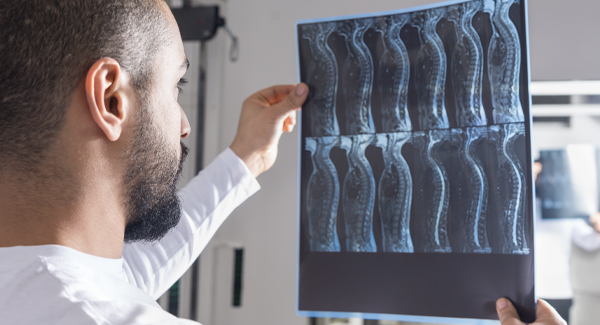Treatment Options for Axial Spondyloarthritis
Whether you have ankylosing spondylitis or nonradiographic axial spondyloarthritis, treatment can slow the disease and make you more comfortable.
Updated April 12, 2022
Treatment for axial spondyloarthritis (axSpa) — including nonradiographic axSpA (nr-axSpA) and ankylosing spondylitis (AS) — aims to:
- Reduce pain and stiffness.
- Prevent deformities.
- Help you continue normal activities.
Disease control involves medication, physical therapy, exercise and living a lifestyle to support your well-being. Treatments include medications, exercise and other lifestyle measures, and sometimes surgery. Work closely with your doctor to devise the best treatment plan for you.
Medications
Medications are an essential part of treatment for most people with axSpA. They may include some of the following:
- NSAIDs. Nonsteroidal anti-inflammatory drugs are usually the first treatment for axSpA. You may be prescribed high doses to control inflammation.
- Sulfasalazine. Conventional synthetic disease-modifying antirheumatic drugs (DMARDs) are not usually used in people with just spinal disease. Sulfasalazine, however, may be used when joints other than those in the back and pelvis are affected and you don't get enough relief from NSAIDs.
- Biologics. These medications will be used if your disease is very active or doesn’t respond well to NSAIDs. The category of biologic that works best for axSpA is called a tumor necrosis factor (TNF) inhibitor. If your disease doesn’t respond to an anti-TNF drug, your doctor may try a biologic that blocks interleukin-17 (IL-17). Several biologics and their biosimilars are currently approved for use in AS: adalimumab (Humira), certolizumab pegol (Cimzia), etanercept (Enbrel), golimumab (Simponi), infliximab (Remicade), ixekizumab (Taltz) and secukinumab (Cosentyx). Three (Cimzia, Taltz and Cosentyx) are approved by the FDA to treat nr-axSpA.
- Analgesics. The pain reliever acetaminophen can ease pain if you aren’t able to take NSAIDs. It won’t reduce inflammation.
- Glucocorticoids (corticosteroids). Injecting this powerful anti-inflammatory directly into your knees or shoulders can provide quick and effective relief. They are not often injected into the spine, and they are not taken by mouth for axSpA.
Every medication comes with risks and possible side effects. Talk to your doctor about your medication risks.
Physical Therapy and Exercise
Regular physical activity is an important piece of your overall treatment plan. The goal is to preserve range of motion in your neck and back. Working with an experienced physical therapist is strongly recommended, especially if you have spinal involvement. The PT can help create a strength and mobility program for you and show you how to move in ways that are beneficial and won't cause further damage.
Exercises that strengthen the back and neck and keep them flexible will help maintain or improve your posture. Deep-breathing exercises and aerobic activities will aid in keeping your chest and rib cage flexible. Swimming is a good option because it keeps your spine, neck, shoulders and hips strong and supple, but if you don't have access to a pool, you should focus on strength-building, flexibility and cardiovascular activities.
Try taking a warm bath or shower to loosen your joints and muscles before you work out. Begin slowly and plan to do your routine when you are the least tired and have the least pain. If you have heart or lung disease, check with your doctor to see if it’s safe to exercise.
Living With AxSpA
Along with physical therapy and medications, you can do many things on your own to take charge of your health and feel better overall.
Be Proactive
- Take a hands-on approach to your treatment.
- Become a good self-manager.
- Build your health care team.
- Keep track of symptoms, medications, side effects and pain levels.
- Get regular check-ups and keep up with your immunizations.
- Ask questions and share concerns with your health care team.
Maintain Good Posture
- Whether you’re sleeping, sitting or standing, maintain a proper body position to prevent joints from fusing in unwanted positions.
- Invest in a firm mattress and try to sleep on your back with a thin pillow or no pillow. Keep your legs straight instead of sleeping in a curled position.
- Keep your back as straight as you can when walking or sitting, with your shoulders squared and your head up.
- Skip corsets and braces. They aren’t usually helpful and may be hurtful in treating AS.
Stop Smoking
If you smoke, stop. Smoking will worsen any lung problems you have from axSpA and may prevent your medications from working fully. If your rib cage is stiff, any smoking-related breathing issues may feel worse.
Use Self-Help Devices
If you have limited mobility, self-help devices can make your daily tasks easier. An occupational therapist can advise you about aids and assistive devices.
Seek Emotional Wellness
Feeling sad, worried or anxious are all common reactions to having a chronic disease. The body-wide inflammation may even contribute to depression. But you can learn to cope with arthritis, improve your mood and ease worries.
Communicate with Your Partner
Limited movement — especially of the hip joint — may get in the way of sexual activity. Some extra planning and communication can help. Discussing your needs with your partner will help you overcome almost any difficulty.
Think about what you do to make yourself comfortable when lying in bed. Then adapt these changes of position to make sexual activities more comfortable and fun for both partners.
Make Workplace Accommodations
The majority of people with axSpA can continue a productive, active work schedule. Whether you work inside or outside the home, the following suggestions may help.
- Avoid lifting, stooping and remaining in cramped or bent positions.
- Raise your computer monitor to eye level so your posture is good.
- Change positions often and move around at least every hour.
- Use a cushion when sitting to help support your back.
- Arrange to take short rest periods throughout the day.
Eat Well
There is no specific diet for AS. However, a food plan rich in vegetables, fruit, fish and healthy fats like olive oil will help support an overall healthful lifestyle.
Ease Pain and Fatigue
Along with exercise and medications, try these methods to relieve pain, fatigue and anxiety.
- Activity pacing. Lighten your schedule and ask for help when you need to. Take breaks during the day to save energy and protect joints.
- Hot and cold treatments. Heat improves blood flow, easing joint stiffness. Cold helps reduce swelling by constricting blood vessels.
- Relaxation techniques. Relax your muscles and slow down your thoughts. Try deep breathing, guided imagery and visualization.
- Massage. Massage can help reduce pain, improve joint function and ease stress and anxiety.
- Topical treatments. Pain creams can be rubbed on the skin over a painful joint. They may contain NSAIDs, salicylates, counter-irritants or capsaicin.
- Acupuncture. Acupuncture is the practice of inserting fine needles at special points into the body to relieve pain.
Surgery
Despite everyone’s best efforts, sometimes joint surgery is necessary to improve your function. Hip and knee replacements are quite successful for people with axSpA. If your spine becomes severely bent forward, surgery may help straighten it. Because the surgery is complex, it’s done in only a few medical centers.

Stay in the Know. Live in the Yes.
Get involved with the arthritis community. Tell us a little about yourself and, based on your interests, you’ll receive emails packed with the latest information and resources to live your best life and connect with others.



